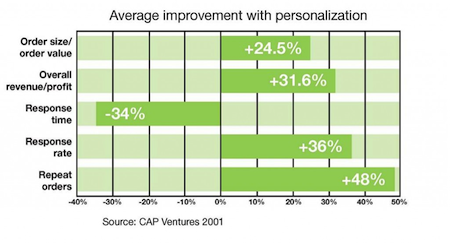 Ask just about any marketing strategist, printer and most businesses what’s in store for the future and those in the know will say their focus is on data, data mining and CRM systems. And in the printing industry we’ll tell you that having data allows you to personalize through variable data printing, which is a very big deal.
Ask just about any marketing strategist, printer and most businesses what’s in store for the future and those in the know will say their focus is on data, data mining and CRM systems. And in the printing industry we’ll tell you that having data allows you to personalize through variable data printing, which is a very big deal.
Transitioning from static direct mail to variable mail is a way that we can help customers stay ahead of the competition. According to data from Cap Ventures, variable data printing allows even the smallest business to compete with Fortune 500 businesses because, when properly executed, it can return up to 30 times the ROI of a static piece.
Variable data printing is being embraced by businesses like grocery stores, retailers, catalogers, casinos, boutiques, hospitals, and insurance companies—all of whom have and collect customer data on a regular basis.
According to a research study by ICMR, Harrah’s Casino increased their customer spend 13% — from 36% in 2000 to 43% in 2002 with its Total Rewards program, which involves monthly VDP mailings to four different customer segments. This concentration on individual motivation spurred an increase in Harrah’s profits to the tune of $251 million within just one year of its implementation.
VDP Resistors and Users
While most organizations have an existing customer database, most times the data is not contained in a single system. This makes it difficult to get a 360-degree picture to target your messaging.
If this rings true for your organization, the sooner you tackle the integration issue the better. Leaving it for years later limits your ability to create strong response rates today.
In Target Marketing’s 2011 analysis of 40 months of data (January 2009 through October 2011), the growth of personalization/VDP (variable data printing) in the direct marketing and mailing process was touted as the 2011 Direct Mail Trend of the Year. Here are some stats from that study:
- In 2009, 28% of direct mail pieces were personalized.
- In 2010, the number of personalized mail pieces increased to 34% — a 21% increase.
- In 2011, seven of the 10 months recorded saw even higher VDP usage – another 21% increase from the prior year and a 46% jump from the 2009 levels.
Stats to Prove VDP is the Beneficial Shot for Growing Your Business
It’s not unusual that marketers feel the work necessary to organize the data isn’t worth using VDP, yet the numbers prove otherwise:
- VDP success is enjoyed by many sectors, from travel to education. For instance, La Salle Academy, a Kansas City-based nonprofit, used a VDP self-mailer for an alumni fundraising campaign and increased the average donation by 67%.
- One of our clients operates a restaurant franchise and used VDP to create customer cards printed with a unique URL and elicited a 27% patron response.
- A municipal federal credit union used VDP postcards to drive $1 million in loan activity and achieve an ROI of over 2,700% for the first year of interest income.
- Combined with personalized URLs, email and telemarketing, a local travel club found that variable data and imagery significantly printing boosted bookings and membership.
- VDP combined with cross channel marketing earned Zodiac Pool Systems a 200% improvement in response without increasing their marketing budget.
There you have it. If you’ve been sitting on the fence thinking about growing your business but not yet considering implementing VDP, follow the lead of the savvy marketers above and build a marketing campaign on the strong foundation of variable data printing. And be prepared to blow your competition away.
Gina Danner is the CEO + Owner of MailPrint, a Kansas City-based direct marketing solutions provider that helps develop and deploy direct marketing systems and marketing portals for hundreds of nationwide and Fortune 500 companies. She’s also served as a past entrepreneurial coach for the Kauffman Foundation’s FastTrack program and for the Pipeline Program for entrepreneurs and is at the top of my list of smart people to pay attention to.
This post first appeared on the MailPrint blog. If you’re not yet subscribing, check them out!
Lead image by bjornmeansbear via Creative Commons
